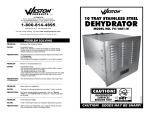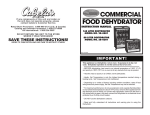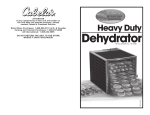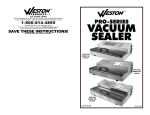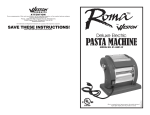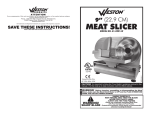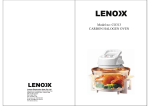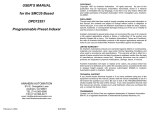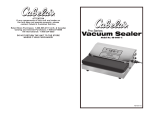Download Cabela's 28-1001-C User's Manual
Transcript
ATTENTION If any components of this unit are broken, do not operate properly, or for product returns, please contact Cabela’s Customer Service. DO NOT RETURN THE UNIT TO THE STORE WHERE IT WAS PURCHASED! Pro Series 10 Tray Digital Dehydrator MODEL NO. 28-1001-C REV071211 Retail Store Purchases: 1-800-905-2731 (U.S & Canada) Catalog & Internet Purchases: 1-800-237-8888 All International: 1-308-234-5555 Drying Guide PROBLEM SOLVING 1 PROBLEM: Moisture in the storage container. CAUSE: Incomplete Drying. Food is cut unevenly, causing incomplete or uneven drying. Drying foods left at room temperature too long after cooling, allows moisture to re-enter the foods. PREVENTION: Test several pieces of food for dryness before removing it from the Dehydrator. Cut foods evenly. Cool quickly and package immediately in an air-tight container. __________________________________________________________________ 1 Cabinet PROBLEM: Mold is on the dehydrated food. CAUSE: Incomplete Drying. The food was not checked for moisture content within a week. The storage container is not air-tight. The storage temperature is too warm. Case hardening may have occurred, meaning the food was dried at too high of a temperature and the food was only dry on the outside, not the inside. PREVENTION: Test several pieces of food for dryness before removing it from the Dehydrator. __________________________________________________________________ 5 4 2 3 -2- PROBLEM: Brown spots on vegetables. CAUSE: Too high of a drying temperature was used. Food is over-dry. PREVENTION: Dry foods at appropriate temperatures. Use the “Drying Guide” on the Control Panel as reference. Check foods often for dryness. __________________________________________________________________ PROBLEM: Food sticking to Trays. CAUSE: Food is not being turned over during the dehydration process. PREVENTION: After one hour of dehydrating, use a spatula and flip the food. Flip the food often until it is no longer sticky. -15- APPLE & CREAM FRUIT LEATHER 6 apples, peeled &cored 1 cup plain non-fat yogurt 1/2 tsp cinnamon 2 1/2 tsp nutmeg 1/4 tsp cloves . Puree the ingredients in a food processor or blender until smooth . Line the Trays with plastic wrap or silicone fruit leather sheets (sold separately) . Spread the puree over the lined Trays until it is about 1/4” (0.6 cm) thick (the edges will dry quicker than the center; pour the puree thinner at the center of the Tray) . Set the Dehydrator to about 135-145oF (57-63oC) for 4-5 hours (a longer drying time may be necessary) . Dehydrate until leathery and pliable but not sticky . Allow to cool slightly, then serve/store NOT-SO SUN DRIED TOMATOES 7 lb firm, ripe Roma tomatoes, stemmed & quartered 1 tsp dried oregano 1 tsp dried thyme 1 tsp dried basil 2 tsp salt . Scrape out all the seed of the tomatoes without removing the pulp . Mix the basil, oregano, thyme and salt together . Place the tomatoes skin side down onto the Trays . Sprinkle the seasoning mixture over the top of the tomatoes . Set the Dehydrator to about 140oF (60oC) for 6-9 hours (a longer drying time may be necessary) . A few hours through the dehydrating process, gently turn the tomatoes over and press flat with a spatula, repeat this step every few hours until the tomatoes are dried . Allow to cool slightly, then serve/store CHEESY CORN CHIPS 1 cup creamed corn 1 Tbsp chopped onion 1 cup grated sharp cheddar cheese 1/2 cup diced res & green bell peppers 1/8 tsp cayenne pepper 1/8 tsp chili powder salt to taste ! WARNING!! Before cleaning or servicing the Dehydrator, make sure it is unplugged from the power source. It is important to read & fully understand all of the instructions & safeguard prior to use of the Dehydrator. COMPONENT LIST DIAGRAM NUMBER 1 2 3 4 5 PART DESCRIPTION Control Panel Tray Drip Tray Foot (4) Power Cord ORANGE SMOOTHIE ROLLS 1 apple, peeled, cored & chopped 1 1/2 tsp vanilla . Puree the ingredients in a food processor or blender until smooth . Line the Trays with plastic wrap or silicone fruit leather sheets (sold separately) . Spread the puree over the lined Trays until it is about 1/4” (0.6 cm) thick (the edges will dry quicker than the center; pour the puree thinner at the center of the Tray) . Set the Dehydrator to about 135-145oF (57-63oC) for 4-8 hours (a longer drying time may be necessary) . Dehydrate until leathery and pliable but not sticky . Allow to cool slightly, then serve/store -14- N/A 28-1003 28-1005 28-1004 N/A Before beginning the assembly, check the package contents for all of the parts. If you are missing any parts, or if any parts are damaged, contact Cabela’s Customer Service. Retail Store Purchases: 1-800-905-2731 (U.S & Canada) Catalog & Internet Purchases: 1-800-237-8888 All International: 1-308-234-5555 . Puree the ingredients in a food processor or blender until smooth . Line the Trays with plastic wrap or silicone fruit leather sheets (sold separately) . Spread the puree over the lined Trays in a ring until it is about 1/4” (0.6 cm) thick (the edges will dry quicker than the center; pour the puree thinner at the center of the Tray) . Set the Dehydrator to about 130oF (55oC) for 10 hours (a longer drying time may be necessary) or until dry on one side . Lift the entire corn ring off of the Trays, turn over and dry for 2 more hours or until crisp . Break into pieces when done . Salt to taste 1 1/2 cup applesauce 2 tsp dried orange ground PART NUMBER -3- RECIPES IMPORTANT SAFEGUARDS WARNING! READ AND FULLY UNDERSTAND ALL INSTRUCTIONS AND WARNINGS PRIOR TO USING THIS UNIT. YOUR SAFETY IS MOST IMPORTANT! FAILURE TO COMPLY WITH PROCEDURES AND SAFE GUARDS MAY RESULT IN SERIOUS INJURY OR PROPERTY DAMAGE. REMEMBER: YOUR PERSONAL SAFETY IS YOUR RESPONSIBILITY! 1. CHECK FOR DAMAGED PARTS. Before using the Dehydrator, check that all parts are operating properly and perform the intended functions. Check for alignment of moving parts, binding of moving parts, mounting and any other conditions that may affect the operation. DO NOT use if power cord is damaged or frayed. DO NOT use this appliance after malfunctions or if the appliance is dropped or damaged in any manner. 2. Reduce risk of unintentional starting. Make sure the Power Switch is in the “OFF” position before connecting the Dehydrator to the power source. 3. Avoid contact with moving parts. 4. ALWAYS DISCONNECT the Dehydrator from the power source before servicing, changing accessories or cleaning the unit. Unplug the Dehydrator when not in use. 5. KEEP CHILDREN AWAY. NEVER LEAVE THE APPLIANCE UNATTENDED. This appliance is NOT a toy. Close supervision is necessary when any appliance is used by or near children. 6. The Manufacturer declines any responsibility in the case of improper use of the Dehydrator. Improper use of the Dehydrator voids the warranty. 7. Electrical repair must be done by an authorized dealer. Use only factory original parts and accessories to avoid injury and retain the warranty. Modification of the Dehydrator voids the warranty. 8. DO NOT pull the Power Cord to unplug. Use care when using extension cords. 9. Be sure the Dehydrator is stable during use. All four feet should be secure on a level surface. The Dehydrator should not move during operation. 10.DO NOT operate the Dehydrator outdoors or near any flammable or combustible materials. 11.DO NOT block the air vents at the rear of the Dehydrator. Keep the Dehydrator at least 6” (15 cm) away from any wall to allow for proper air circulation. 12.DO NOT operate the Dehydrator on flammable surfaces such as carpeting. 13.To prevent electric shock, DO NOT IMMERSE CORD, PLUG OR BODY IN WATER OR LIQUID. Serious injury and electric shock could result. DO NOT use this machine with wet hands or bare feet. DO NOT operate near running water. 14.NEVER open or remove the back panel of the Dehydrator. 15.Disconnect from power source before cleaning the components of this machine. READ ALL DIRECTIONS on how to clean this Dehydrator before attempting to clean it. Allow the appliance to cool before handling. 16.After cleaning, make sure Dehydrator is completely dry before reconnecting to the power source – if not; ELECTRIC SHOCK may result. 17.DO NOT operate the Dehydrator on a hot stovetop, gas burners or inside an oven. DO NOT allow the Power Cord to drape over the Dehydrator, hot surfaces or over the edge of the work surface. 18.BEWARE! Some surfaces may become very hot during use! Serious injury may result! DO NOT move the Dehydrator while in use. DO NOT move the Dehydrator while hot. Allow the appliance to cool before handling. Use Handles. Extreme caution must be used when moving an appliance containing hot oil or other hot liquids. 19. The use of accessory attachments not recommended by the appliance manufacturer may cause injury and void warranty. 20.DO NOT use the appliance for other than the intended use. 21.DO NOT use while under influence of drugs or alcohol. 22.Household use only. SAVE THESE INSTRUCTIONS! Refer to them often and use them to instruct others. -4- HAWAIIAN JERKY MARINADE 1 tsp salt 1 tsp ground ginger 1/4 cup pineapple juice 1 Tbsp brown sugar 1/4 tsp pepper 1/8 tsp cayenne pepper 1 crushed garlic clove 1/4 cup soy sauce 1 lb lean meat, sliced into 1/8-1/4” (0.3-0.6 cm) thin strips . Follow Marinading Instructions below CAJUN MARINADE 1 cup tomato juice 1/2 tsp garlic powder 1/2 tsp ground black pepper 1 1/2 tsp dried thyme 1 1/2 tsp dried basil 1 1/2 tsp onion powder 1 tsp white pepper 2 tsp cayenne pepper 1 lb lean meat, sliced into 1/8-1/4” (0.3-0.6 cm) thin strips . Follow Marinading Instructions below HOT JERKY MARINADE 1-3 cup teriyaki 2 tsp brown sugar 2 tsp ground black pepper 1 tsp ground horseradish 1 tsp salt 1/2 tsp paprika 1/2 tsp chili powder 1 Tbsp olive oil 1 Tbsp minced garlic 1/4 tsp Tabasco Sauce 2 Tbsp seeded & finely chopped Jalapeño peppers 1 lb lean meat, sliced into 1/8-1/4” (0.3-0.6 cm) thin strips . Follow Marinading Instructions below BURGUNDY MARINADE 2 cups burgundy wine 1/2 cup soy sauce 3 cloves chopped garlic 3 Tbsp molasses syrup 1 Tbsp ground black pepper 1 lb lean meat, sliced into 1/8-1/4” (0.3-0.6 cm) thin strips . Follow Marinading Instructions below MARINADING INSTRUCTIONS . . . . . . . . . Combine all ingredients, except for the meat in a glass bowl, mix well Place a layer of meat into a glass baking dish Spoon the sauce mixture over the layer of meat Continue to layer the meat and sauce until the meat is about 3-4 layers deep Cover lightly and place the dish in the refrigerator overnight Stir occasionally to keep the meat coated with marinade Remove the meat from the marinade, removing excess marinade Lay the meat evenly onto the Trays, leaving 1/4” (0.6 cm) space between each strip Follow the “MAKING JERKY” instructions in this manual -13- refrigerated so they cool rapidly. Make sure to cover foods after they are cool. NOTE: Special considerations must be made when using venison or other wild game, since it can become heavily contaminated during field dressing. Venison is often held at temperatures that could potentially allow bacteria to grow, such as when it is being transported. Refer to the USDA Meat and Poultry Department for further questions or information on meat and food safety. CLEANING INSTRUCTIONS ! WARNING!! Before cleaning or servicing the Dehydrator, make sure it is unplugged from the power source. It is important to read & fully understand all of the instructions & safeguard prior to use of the Dehydrator. 1. Clean the Trays and inside the Cabinet before using the Dehydrator for the first time and after each use. 2. Push the Power ON/OFF Button to turn off the Dehydrator. Disconnect the Power Cord from the electrical outlet. TIPS . Use the best quality foods. Fruits and vegetables in peak season have more nutrients and more flavor. Do not use food with bruises or blemishes. Bad fruits and vegetables may spoil the entire batch. . Use the best quality meats. Meats, fish and poultry should be lean and fresh. Remove as much fat as possible before dehydrating. . Do not overlap foods. Lay foods flat on the Trays. . Check dryness after a few hours, then check every two hours until dehydrated. Open or cut down the middle if a few samples to check internal dryness. If the food is still moist, dehydrate longer. . Use the Drying Guide on the Control Panel as reference for proper temperature settings. If the heat is set too high, the food may case harden, meaning the food is dried at too high of a temperature and the food was only dry on the outside, not the inside. If the temperature is too low, the drying time will increase. . Remember, foods will shrink approximately 1/4 to 1/2 their original size and weight during the dehydration process, so pieces should not be kept too small. One pound of raw meat will yield approximately 1/3 lb. (0.2 kg) of jerky. . Do not place items to be dried on the Drip Tray, there will be no circulation of air on this Tray. Clean the Drip Tray periodically during dehydration for easier cleanup. 3. Allow the Dehydrator to completely cool before cleaning. 4. Remove the Trays from the Cabinet. 5. Wipe the Cabinet clean, inside and out, with damp sponge or soft cloth. Be careful not to splash water onto the heating element (located behind the screening and fan in the back of the Cabinet) while cleaning the inside of the Cabinet. Water could damage the heating element and the increases the risk of electric shock. DO NOT immerse the Dehydrator in water. 6. Clean the Trays with warm, soapy water. Rinse with clear water and dry immediately. GROUNDING INSTRUCTIONS GROUNDING This appliance must be grounded while in use to protect the operator from electrical shock. The appliance is equipped with a 3-conductor cord and a 3-prong grounding type plug to fit the proper grounding-type receptacle. The appliance has a plug that looks like Figure A. An adaptor, Figure B, should be used for connecting Figure A plugs to two-prong receptacles. The grounding tab which extends from the adaptor must be connected to a permanent ground such as a properly grounded outlet box as shown in Figure C using a metal screw. Figure A Grounding Prong Circuit Grounding Conductor Figure B Metal Grounding Screw Cover of Grounded Outlet Box Figure C -12- -5- Grounding Means AA2220 OPERATING INSTRUCTIONS ! WARNING!! Before cleaning or servicing the Dehydrator, make sure it is unplugged from the power source. It is important to read & fully understand all of the instructions & safeguard prior to use of the Dehydrator. 1. Plug the Dehydrator into a standard 120 Volt, 60 Hz wall outlet. 2. Position the Dehydrator as to NOT block the air vents at the rear of the Dehydrator. Keep the Dehydrator at least 12” (30.5 cm) away from any wall to allow for proper air circulation. DO NOT operate the Dehydrator on or near flammable surfaces such as carpeting. 3. Turn the Dehydrator on by pressing the POWER ON/OFF Button (figure A). 4. Press the SETTING/RESET Button and by using the “-” and the “+” Buttons, set the desired temperature. 5. Press the SETTING/RESET Button and by using the “-” and the “+” Buttons, set the drying hours. 6. Press the SETTING/RESET Button once more and by using the “-” and the “+” Buttons, set the minutes (in 5 minute increments). 7. Press the START/STOP Button. A “click” will be heard and the Dehydrator will start cycling. NOTE: Pressing the START/STOP Button will not pause the Dehydrator, it will stop the Dehydrator and reset it. Refer to the “Special Start/Stop Note” in this booklet. 8. Preheat the Dehydrator for 5-10 minutes at the desired temperature before loading food onto the Trays. 9. Remove any excess water from the food (this can be done by patting the food with a paper towel or napkin). Excess moisture may cause the Dehydrator temperature to drop. 10.Load the Trays with the items to be dried. Position the pieces so that they do not touch each other. Do not overlap or allow the product to touch. Allow ample space between the products for proper air circulation. 11.Water droplets may form on the surface of some products while dehydrating. Periodically blot the product with a clean paper towel. NOTE: Drying times may vary based on many circumstances including but not limited to: the relative humidity of the room, the temperature of the food at the beginning of the drying process, the amount of food in the Dehydrator, the leanness of the meat, etc. Figure A -6- FOOD SAFETY CAUTION! It is important to follow the “Food Safety” guidelines outlined in this manual. For the most up to date instruction visit the USDA website. There are basic rules to follow when handling food. They are COOK, SEPARATE, CLEAN, and CHILL. COOK It’s crucial to cook food to a safe internal temperature to destroy bacteria that is present. The safety of hamburgers and other foods made with ground meat has been receiving a lot of attention lately, and with good reason. When meat is ground, the bacteria present on the surface is mixed throughout the ground mixture. If this ground meat is not cooked o o o o to at least 160 F to 165 F (71 C to 74 C), bacteria will not be destroyed and there’s a good chance you will get sick. Solid pieces of meat like steaks and chops don’t have dangerous bacteria like E. coli on the inside, so they can be served more rare. Still, any beef cut should be cooked to an o o internal temperature of at least 145 F (63 C) (medium rare). The safe temperature for o o o o poultry is 180 F (82 C) and solid cuts of pork should be cooked to 160 F (71 C). Eggs should be thoroughly cooked too. If you are making a meringue or other recipe that uses uncooked eggs, buy specially pasteurized eggs or use prepared meringue powder. SEPARATE Foods that will be eaten uncooked and foods that will be cooked before eating MUST ALWAYS be separated. Cross-contamination occurs when raw meats or eggs come in contact with foods that will be eaten uncooked. This is a major source of food poisoning. Always double-wrap raw meats and place them on the lowest shelf in the refrigerator so there is no way juices can drip onto fresh produce. Then use the raw meats within 1-2 days of purchase, or freeze for longer storage. Defrost frozen meats in the refrigerator, not on the counter. When grilling or cooking raw meats or fish, make sure to place the cooked meat on a clean platter. Don’t use the same platter you used to carry the food out to the grill. Wash the utensils used in grilling after the food is turned for the last time on the grill, as well as spatulas and spoons used for stir-frying or turning meat as it cooks. Make sure to wash your hands after handling raw meats or raw eggs. Washing hands with soap and water, or using a pre-moistened antibacterial towelette is absolutely necessary after you have touched raw meat or raw eggs. Not washing hands and surfaces while cooking is a major cause of cross-contamination. CLEAN Wash your hands and work surfaces frequently when you are cooking. Washing with soap and warm water for at least 15 seconds, then dry with a paper towel. CHILL Chilling food is very important. The danger zone where bacteria multiply is between o o o o o o 40 F and 140 F (4 C and 6 C). Your refrigerator should be set to 40 F (4 C) or below; o o your freezer should be 0 F (-17 C) or below. Simple rule: serve hot foods hot, cold foods cold. Use chafing dishes or hot plates to keep food hot while serving. Use ice water baths to keep cold foods cold. Never let any food sit at room temperature for more than o o 2 hours - 1 hour if the ambient temperature is 90 F (32 C) or above. When packing for a picnic, make sure the foods are already chilled when they go into the insulated hamper. The hamper won’t chill food - it just keeps food cold when properly packed with ice. Hot cooked foods should be placed in shallow containers and immediately -11- RE-HYDRATING FOODS SPECIAL START/STOP NOTE CAUTION! It is important to follow the “Food Safety” guidelines outlined in this manual. For the most up to date instruction visit the USDA website. When operating the Dehydrator, if the START/STOP Button is pressed while the Dehydrator is in the middle of a cycle, the heating element and the timer for the unit will turn off, but the fan will continue to run for 1 minute. This is normal, and occurs to help cool the heating element and prevent overheating. The temperature will continue to display on the Dehydrator until POWER ON/OFF Button is pressed. WARNING! DO NOT soak food at room temperature. Soaking at room temperature allows harmful bacteria to grow. Follow the “Food Safety” guidelines outlined in this manual. . Dehydrated food can be re-hydrated by soaking in cold water for 3-5 minutes or for 2-6 hours in the refrigerator in water. Use 1 cup of water for 1 cup of dehydrated food. Once re-hydrated, the food can be cooked normally. Soaking foods in warm water will speed up the process however; it may result in loss of flavor. . Do not add seasoning. Adding salt or sugar during re-hydration may change the flavor of the food. . To make stewed fruits or vegetables, add 2 cups of water and simmer until tender. . Consume dehydrated foods as soon as possible once the storage container is opened. Keep any unused portions in the refrigerator to avoid contamination. DRYING FLOWERS & CRAFTS ! WARNING!! Before cleaning or servicing the Dehydrator, make sure it is unplugged from the power source. It is important to read & fully understand all of the instructions & safeguard prior to use of the Dehydrator. . Flowers should be dry to start with, best of picked after the dew has dried and before the night damp sets in. Dry the flowers as soon as possible after picking. . The best condition for drying flowers is a dry, warm, dark, clean and well ventilated area, which makes a dehydrator an ideal setting. Flowers will retain the best color and condition when dried quickly. . A low temperature should be used to retain the natural oils. Drying times will vary considerably depending on the size of the flower and the amount of foliage. Dry at 100oF (38oC). . Strip off the leaves or if you prefer to keep the foliage. Discard any brown or damaged leaves. . Place on the Tray in a single layer, avoiding overlapping. . Dough art and beads can be dried in the Dehydrator. Temperatures may vary. PRE-TREATMENT OF FOODS CAUTION! It is important to follow the “Food Safety” guidelines outlined in this manual. For the most up to date instruction visit the USDA website. As with most types of cooking, proper preparation is essential for successful results. Adhering to a few basic guidelines will generally increase the quality of your dried foods and decrease the amount of time necessary to dry them. Pre-treated foods often taste better and have a better appearance than non-treated foods. There are several methods to pre-treat food to prevent oxidation, which will darken apples, pears, peaches and bananas while drying. . Remove any pits, skin, cores or bones. . Shred, slice or dice the food uniformly. Slices should be between 1/8-1/4” (0.3-0.6 cm) thick. Meats should be cut not more than 3/4” (1.9 cm) thick. . IMPORTANT: Before placing the meat in a Dehydrator, it is HIGHLY RECOMMENDED to heat the meat to 160oF (71oC), poultry to 165oF (74oC), as measured with a food thermometer in an oven BEFORE starting the dehydration process. This step assures that any bacteria present will be destroyed by wet heat. After heating to 160oF (71oC), poultry to 165oF (74oC), maintain a constant dehydrator temperature of 130-140oF (55-60oC) during the drying process. The minimum recommended temperature for drying meats is 145oF (63oC). Temperatures below 145oF (63oC) are NOT recommended. . Steam or bake the fish at 200’F (93’C) until flaky before dehydrating. . Drying into jerky requires a lot of attention. It must be cleaned and de-boned properly and rinsed thoroughly to ensure that all the blood is washed away. . Soak cut fruit in either lemon or pineapple juice for a few minutes before placing out on the Trays. . Use an ascorbic acid mix which can be purchased in most health food stores or pharmacies. It may come in either powder or tablet form. Dissolve approximately 2-3 tablespoons into 1 quart (1 liter) of water. Soak the fruit slices into the solution for 2-3 minutes, then place on the Trays. . Fruits with a wax coating (figs, peaches, grapes, blueberries, prunes, etc.) should be dipped in boiling water to remove the wax. This allows moisture to escape easily when dehydrating. -10- -7- . Blanching can pre-treat food for dehydrating. Blanching does not destroy helpful enzymes and helps retain nutrients. There are two ways to blanch food: . You may need to blot fat droplets from the surface of the meat occasionally using a paper towel. 1. WATER BLANCHING: Use a large pan; fill it half way with water. Bring water to a boil. Place food directly in a boiling water and cover. Remove after three minutes. Arrange food on the Trays. . Drying times may vary based on many circumstances including but not limited to: the relative humidity of the room, the temperature of the meat at the beginning of the drying process, the amount of meat in the Dehydrator, the leanness of the meat, etc. 2. STEAM BLANCHING: Using steamer pot bring 2-3” (5-7 cm) of water to a boil in bottom section. Place food in steamer basket and steam for 3-5 minutes. Remove steamed food and arrange on Trays. . Always allow jerky to cool before taste testing to avoid burns. MAKING JERKY CAUTION! It is important to follow the “Food Safety” guidelines outlined in this manual. For the most up to date instruction visit the USDA website. . Use the best quality meats. Meats, fish and poultry should be lean and fresh. Remove as much fat as possible before dehydrating. Using lean meat will help the meat dry faster and aid in cleanup by decreasing the drippings. Ground meat should be 80% to 90% lean. Ground turkey, venison, buffalo and elk are other excellent choices for jerky. . Jerky seasonings are available for all tastes. Whenever making jerky, treat the mixture with cure (sodium nitrate). The cure is used to help prevent botulism during drying at low temperatures. Follow all of the manufacturer’s directions on the cure packet. . Keep raw meats and their juices away from other foods. Marinate meats in the refrigerator. Do not leave meats un-refrigerated. Prevent cross-contamination by storing dried jerky away from raw meat. Always wash hands thoroughly with soap and water before and after working with meat products. Use clean equipment and utensils. STORING JERKY CAUTION! It is important to follow the “Food Safety” guidelines outlined in this manual. For the most up to date instruction visit the USDA website. . First wrap jerky in aluminum foil or wax paper, then store in a thick plastic food storage bag, metal, glass or plastic containers. Remove as much air as possible before sealing. Seal tightly. . Vacuum sealing is ideal for keeping dried foods. . Jerky should be stored in a cool, dark, dry place between 50-60oF (10-16oC) or lower. Jerky can be stored, if properly dried, at room temperature for 1 or 2 months. To extend shelf life to up to 6 months, store jerky in the freezer. . Be sure to label and date all packages with contents, ingredients, original weight and date processed. . Keep a journal to help improve drying techniques. . Keep meat and poultry refrigerated at 40oF (5oC) or slightly below; use or freeze ground beef and poultry within 2 days; whole red meats, within 3 to 5 days. Defrost frozen meat bin the refrigerator, not on the counter. . Special considerations must be made when using venison or other wild game, as it can become heavily contaminated during field dressing. Venison is often held at temperatures that could potentially allow bacteria to grow, such as when it is being transported. Refer to the USDA Meat and Poultry Department for further questions or information on meat and food safety. . IMPORTANT: Before placing the meat in a Dehydrator, it is HIGHLY RECOMMENDED to heat the meat to 160oF (71oC), poultry to 165oF (74oC), as measured with a food thermometer in an oven BEFORE starting the dehydration process. This step assures that any bacteria present will be destroyed by wet heat. After heating to 160oF (71oC), poultry to 165oF (74oC), maintain a constant dehydrator temperature of 145-155oF (63-68oC) during the drying process. Temperatures below 145oF (63oC) are NOT recommended. . If using a marinade, shake off excess liquid before placing the meat on the Trays. . Evenly space the meat in single layers approximately 1/4” (0.64 cm) apart on the Trays. -8- -9-








